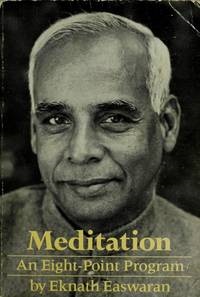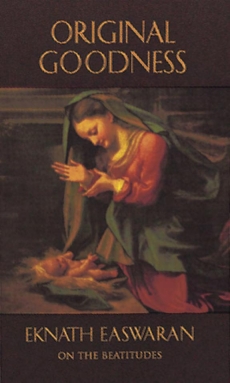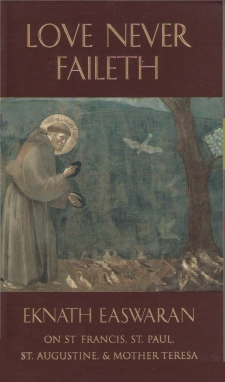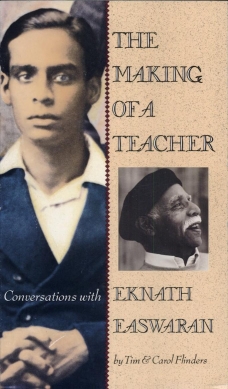
Eknath Easwaran was an Indian-born spiritual teacher, author and translator and interpreter of Indian religious texts such as the Bhagavad Gita and the Upanishads.

Japa is the meditative repetition of a mantra or a divine name. It is a practice found in Hinduism, Jainism, Sikhism, and Buddhism, with parallels found in other religions.

Passage Meditation is a book by Eknath Easwaran, originally published in 1978 with the title Meditation. The book describes a meditation program, also now commonly referred to as Passage Meditation. Easwaran developed this method of meditation in the 1960s, and first taught it systematically at the University of California, Berkeley.

The Katha Upanishad is one of the mukhya (primary) Upanishads, embedded in the last eight short sections of the Kaṭha school of the Krishna Yajurveda. It is also known as Kāṭhaka Upanishad, and is listed as number 3 in the Muktika canon of 108 Upanishads.

Dhyāna in Hinduism means contemplation and meditation. Dhyana is taken up in Yoga practices, and is a means to samadhi and self-knowledge.

The Bhagavad Gita, often referred to as the Gita, is a 700-verse Hindu scripture, which is part of the epic Mahabharata. It forms the chapters 23–40 of book 6 of the Mahabharata called the Bhishma Parva. The work is dated to the second half of the first millennium BCE. Typical of the Hindu synthesis, it is considered one of the holy scriptures of Hinduism.

Nonviolent Soldier of Islam is a biography of Khan Abdul Ghaffar Khan (1890-1988), an ally of Gandhi's in the Indian independence movement. Originally written by Eknath Easwaran in English, foreign editions have also been published in Arabic and several other languages. The book was originally published in the United States in 1984 as A Man to Match His Mountains: Badshah Khan, nonviolent soldier of Islam. A second edition was published in 1999 with the title Nonviolent soldier of Islam: Badshah Khan, a man to match his mountains. Both editions include an afterword by Timothy Flinders. The 1999 US edition contains a new foreword by Easwaran, and an enlarged section of photographs of Khan. The book has been reviewed in magazines, newspapers, and professional journals. The book inspired the making of the 2008 film The Frontier Gandhi: Badshah Khan, a Torch for Peace.

Gandhi the Man is a biography of Mohandas Karamchand Gandhi written by Eknath Easwaran. The book was originally published in the United States in 1973. Several subsequent expanded editions have been published. Non-English editions have also been published in several languages.

The Mantram Handbook describes methods of using a mantram — sometimes called a Holy Name — in daily living. Benefits are also described. Written by Eknath Easwaran, the book was originally published in the United States in 1977. Several subsequent editions have been published, sometimes under different titles, in the United States, the United Kingdom, and India. Foreign (non-English) editions have also been published in several languages. The book has been reviewed in newspapers, magazines, and websites, and discussed in professional journals. It has also been a focus of scientific research. The subtitle of the fifth (2008) US edition is: a practical guide to choosing your mantram & calming your mind.
Carol Lee Flinders is a writer, independent scholar, educator, speaker, and former syndicated columnist. She is best known as one of the three authors of Laurel's Kitchen along with Laurel Robertson and Bronwen Godfrey. She is also the co- author of The Making of a Teacher with Tim Flinders.

The Dhammapada / Introduced & Translated by Eknath Easwaran is an English-language book originally published in 1986. It contains Easwaran's translation of the Dhammapada, a Buddhist scripture traditionally ascribed to the Buddha himself. The book also contains a substantial overall introduction of about 70 pages, together with introductory notes to each of the Dhammapada's 26 chapters. English-language editions have also been published in the UK and India, and a re-translation of the full book has been published in German. and Korean.

God Makes the Rivers to Flow is an anthology of spiritual texts for use in meditation, assembled by Eknath Easwaran. Condensed versions have been published under the titles Timeless Wisdom (book) and Sacred Literature of the World. First published as a book in the US in 1982, progressively enlarged or revised versions of God Makes the Rivers to Flow were also issued in the US in 1991, 2003, and 2009. English editions have been published in India, and a French edition has been published. The book has been reviewed in newspapers, magazines, professional journals, and websites, and utilized in research studies and education.
Mgr. John Palocaren (1886–1948) was the founding principal of St. Thomas College, Thrissur. Palocaren was born on 8 September 1886 in the Nadathara Palocaren family, an ancient Syrian Christian family of Kerala State, India. He was ordained as a minister in 1915, served at the St Thomas High School in Thrissur for three years, and was appointed the principal of St Thomas College when it was founded in April 1919. Soon after, he obtained MA in English Literature with distinction from the University of Edinburgh. In 1924 he returned as principal of St Thomas College, a status he retained until 1948. In 1937, he was awarded the status of Monsignor. Palocaren died on 19 August 1948. The 125th anniversary of his birth was celebrated at the college on 8 September 2011.

Original Goodness is a practical commentary on the Sermon on the Mount, emphasizing how to translate it into daily living with the aid of spiritual practices. Written by Eknath Easwaran, the book was originally published in the United States in 1989.

Love Never Faileth is a practical commentary on Saint Francis, Saint Paul, Saint Augustine, and Mother Teresa. Written by Eknath Easwaran, the book was originally published in the United States in 1984.

Seeing with the Eyes of Love by Eknath Easwaran is a practical commentary on The Imitation of Christ, a Christian devotional classic of the early 15th century, believed to be the work of Thomas à Kempis. Easwaran's commentary emphasizes how to translate the Imitation into daily living with the aid of spiritual practices. Seeing with the Eyes of Love was originally published in the United States in 1991. A German translation was published in 1993, and a second U.S. edition was published in 1996. The book has been reviewed in newspapers, magazines, and websites.

The Making of a Teacher is a spiritual biography of the Indian spiritual teacher Eknath Easwaran (1910–1999), written by Tim and Carol Flinders and originally published in the United States in 1989. Adopting an oral history approach, the book recounts numerous conversations with Easwaran that describe his childhood, career as a professor of English literature, spiritual awakening, and service as a spiritual teacher in the United States. The book also profiles his way of life at the time of publication, and his relationship with his grandmother, his own spiritual teacher. An Indian edition was published in 2002. The book has been reviewed in newspapers, and also excerpted.

Conquest of Mind is a book that describes practices and strategies for leading the spiritual life. Written by Eknath Easwaran, the strategies are intended to be usable within any major religious tradition, or outside of all traditions. The book was originally published in the United States in 1988. Multiple revised English-language editions have been published, and translations have also appeared in several other European and Asian languages. The book has been reviewed in newspapers and magazines.
Ratha Kalpana is a metaphor used in Hindu scriptures to describe the relationship between the senses, mind, intellect and the Self. The metaphor was first used in the Katha Upanishad and is thought to have inspired similar descriptions in the Bhagavad Gita, the Dhammapada and Plato's Phaedrus. Gerald James Larson, a scholar of Indian philosophies, believes that the chariot metaphor contains one of the earliest references to ideas and terminology of the Indian philosophical school Samkhya.

The Tejobindu Upanishad is a minor Upanishad in the corpus of Upanishadic texts of Hinduism. It is one of the five Bindu Upanishads, all attached to the Atharvaveda, and one of twenty Yoga Upanishads in the four Vedas.

















